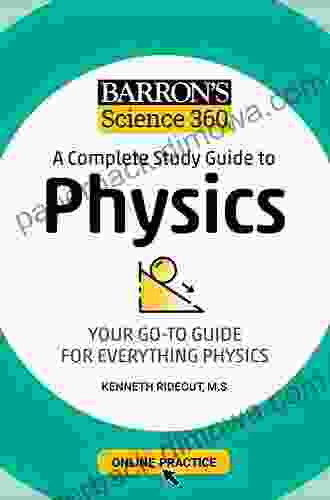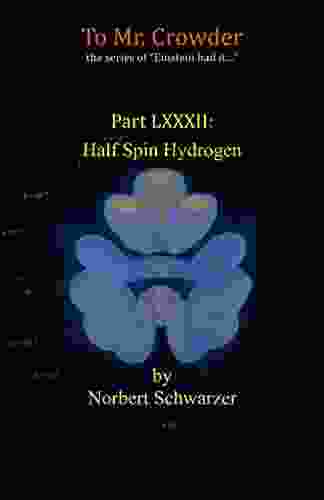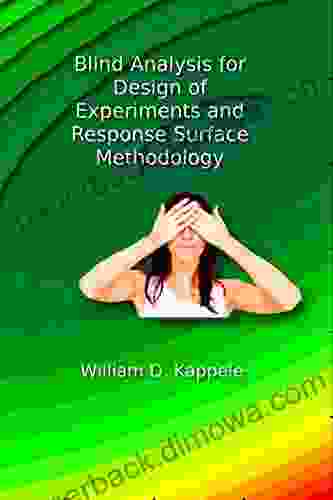Blind Analysis For Design Of Experiments And Response Surface Methodology

In the realm of scientific research and engineering, the ability to design and conduct effective experiments is paramount. Design of Experiments (DOE) and Response Surface Methodology (RSM) are two powerful statistical techniques that enable researchers to optimize processes, products, and systems.
However, to ensure unbiased and reliable results, it is essential to employ blind analysis techniques. Blind analysis involves concealing the identities of experimental treatments from the analysts, eliminating any potential bias that may arise from subjective judgment.
5 out of 5
| Language | : | English |
| File size | : | 5560 KB |
| Screen Reader | : | Supported |
| Print length | : | 170 pages |
| Lending | : | Enabled |
| Paperback | : | 390 pages |
| Item Weight | : | 1.34 pounds |
| Dimensions | : | 6.14 x 0.88 x 9.21 inches |
This article delves into the intricacies of blind analysis, providing a comprehensive guide to its application in DOE and RSM. By mastering these techniques, researchers can unlock the full potential of these statistical methods, leading to groundbreaking discoveries and advancements.
Blind Analysis in Design of Experiments
DOE is a statistical method used to investigate the effects of multiple independent variables on a response variable. Blind analysis plays a crucial role in DOE by preventing the analysts from introducing bias during the data analysis phase.
There are two primary types of blind analysis in DOE:
- Single-Blind Analysis: Only the analysts are unaware of the treatment assignments, while the experimenter and participants are aware.
- Double-Blind Analysis: Neither the analysts nor the participants are aware of the treatment assignments, ensuring complete objectivity.
Single-blind analysis is often used in pilot studies or when it is not feasible to conceal the treatment assignments from the participants. Double-blind analysis is considered the gold standard for unbiased data analysis, as it eliminates any subconscious biases that may influence the results.
Blind Analysis in Response Surface Methodology
RSM is a statistical technique used to optimize responses by exploring the relationship between independent variables and a response variable. Blind analysis is equally important in RSM, as it helps to ensure that the response surface model is unbiased and accurately represents the true relationship between the variables.
In RSM, blind analysis can be implemented through:
- Coded Variables: The independent variables are represented using coded values, which conceal their actual values from the analysts.
- Randomization: The Free Download of experimental runs is randomized to minimize the effects of any systematic bias.
- Cross-Validation: The response surface model is validated using a separate set of data to ensure its accuracy and robustness.
By incorporating these blind analysis techniques into RSM, researchers can gain confidence in the validity of their response surface models and make informed decisions about process optimization.
Benefits of Blind Analysis
Employing blind analysis techniques in DOE and RSM offers numerous benefits, including:
- Unbiased Results: By concealing the treatment assignments from the analysts, blind analysis eliminates any potential for subjective bias to influence the data analysis.
- Increased Accuracy: Unbiased results lead to more accurate and reliable s, enhancing the validity of research findings.
- Improved Decision-Making: Based on unbiased results, researchers can make informed decisions about process optimization and product development.
- Enhanced Credibility: Blind analysis lends credibility to research findings, as it demonstrates the objectivity and rigor of the experimental design and data analysis.
Applications of Blind Analysis
Blind analysis has found widespread applications in various fields, including:
- Pharmaceutical Research: Ensuring unbiased evaluation of drug efficacy and safety.
- Manufacturing: Optimizing production processes to improve quality and efficiency.
- Materials Science: Identifying optimal compositions and properties of new materials.
- Agricultural Research: Evaluating the effects of fertilizers and crop treatments on crop yield.
The versatility of blind analysis makes it an invaluable tool for researchers across diverse disciplines, enabling them to uncover valuable insights and drive innovation.
Blind analysis is an essential element of Design of Experiments and Response Surface Methodology, providing researchers with a powerful tool to design unbiased experiments and optimize responses.
By concealing the identities of experimental treatments from the analysts, blind analysis eliminates subjective bias, leading to more accurate and reliable results. This ultimately enhances the decision-making process, drives innovation, and advances scientific knowledge.
As research methodologies continue to evolve, blind analysis will remain a cornerstone of rigorous experimental design and data analysis, empowering researchers to unlock the full potential of statistical techniques.
5 out of 5
| Language | : | English |
| File size | : | 5560 KB |
| Screen Reader | : | Supported |
| Print length | : | 170 pages |
| Lending | : | Enabled |
| Paperback | : | 390 pages |
| Item Weight | : | 1.34 pounds |
| Dimensions | : | 6.14 x 0.88 x 9.21 inches |
Do you want to contribute by writing guest posts on this blog?
Please contact us and send us a resume of previous articles that you have written.
 Book
Book Novel
Novel Page
Page Chapter
Chapter Text
Text Story
Story Genre
Genre Reader
Reader Library
Library Paperback
Paperback E-book
E-book Magazine
Magazine Newspaper
Newspaper Paragraph
Paragraph Sentence
Sentence Bookmark
Bookmark Shelf
Shelf Glossary
Glossary Bibliography
Bibliography Foreword
Foreword Preface
Preface Synopsis
Synopsis Annotation
Annotation Footnote
Footnote Manuscript
Manuscript Scroll
Scroll Codex
Codex Tome
Tome Bestseller
Bestseller Classics
Classics Library card
Library card Narrative
Narrative Biography
Biography Autobiography
Autobiography Memoir
Memoir Reference
Reference Encyclopedia
Encyclopedia Julius Lester
Julius Lester Vien R Guenther
Vien R Guenther Justin Doherty
Justin Doherty Karl Kroeger
Karl Kroeger K B Akhilesh
K B Akhilesh Kara Mcdowell
Kara Mcdowell Kaloyan Dobrev
Kaloyan Dobrev Nathan Sacks
Nathan Sacks Kekla Magoon
Kekla Magoon Michael Swigunski
Michael Swigunski Rachael Rodgers
Rachael Rodgers Philip Caveney
Philip Caveney Katharina Finke
Katharina Finke Steve Rivkin
Steve Rivkin Marie Silk
Marie Silk Kenneth S Deffeyes
Kenneth S Deffeyes Larry Booth
Larry Booth Kara Powell
Kara Powell Ayaz Memon
Ayaz Memon Kelly Fenathra
Kelly Fenathra
Light bulbAdvertise smarter! Our strategic ad space ensures maximum exposure. Reserve your spot today!

 Dominic SimmonsUnveiling the Hidden Gems of Washington, D.C.: A Journey Through Secret...
Dominic SimmonsUnveiling the Hidden Gems of Washington, D.C.: A Journey Through Secret...
 Thomas PynchonAll Aboard the Adventure Train: Embark on an Extraordinary Literary Journey...
Thomas PynchonAll Aboard the Adventure Train: Embark on an Extraordinary Literary Journey...
 David PetersonDisaster in Three Acts: A Thriller that Will Keep You on the Edge of Your...
David PetersonDisaster in Three Acts: A Thriller that Will Keep You on the Edge of Your... Jeremy MitchellFollow ·2.4k
Jeremy MitchellFollow ·2.4k Elliott CarterFollow ·10.6k
Elliott CarterFollow ·10.6k Alvin BellFollow ·13.3k
Alvin BellFollow ·13.3k Greg CoxFollow ·13.2k
Greg CoxFollow ·13.2k Joseph ConradFollow ·6.5k
Joseph ConradFollow ·6.5k Todd TurnerFollow ·18k
Todd TurnerFollow ·18k Edmund HayesFollow ·19.5k
Edmund HayesFollow ·19.5k Earl WilliamsFollow ·3.1k
Earl WilliamsFollow ·3.1k

 Reginald Cox
Reginald CoxUnlocking the Secrets of Corporate Finance: Explore the...
In the ever-evolving world of business, a...

 David Peterson
David PetersonUncover the Depths of Steinbeck's 'Of Mice and Men' with...
Unlock New Insights and Conquer Your Exams ...

 John Keats
John KeatsUnveiling the Heart-Tugging Memoirs of Soldier Friend: A...
Step into the extraordinary world of...

 Chad Price
Chad PriceUnlock Physics Mastery with Barron's Comprehensive Study...
Elevate your physics...

 Dave Simmons
Dave SimmonsEinstein Had It Part Lxxxii: Half Spin Hydrogen
In the realm of...
5 out of 5
| Language | : | English |
| File size | : | 5560 KB |
| Screen Reader | : | Supported |
| Print length | : | 170 pages |
| Lending | : | Enabled |
| Paperback | : | 390 pages |
| Item Weight | : | 1.34 pounds |
| Dimensions | : | 6.14 x 0.88 x 9.21 inches |








